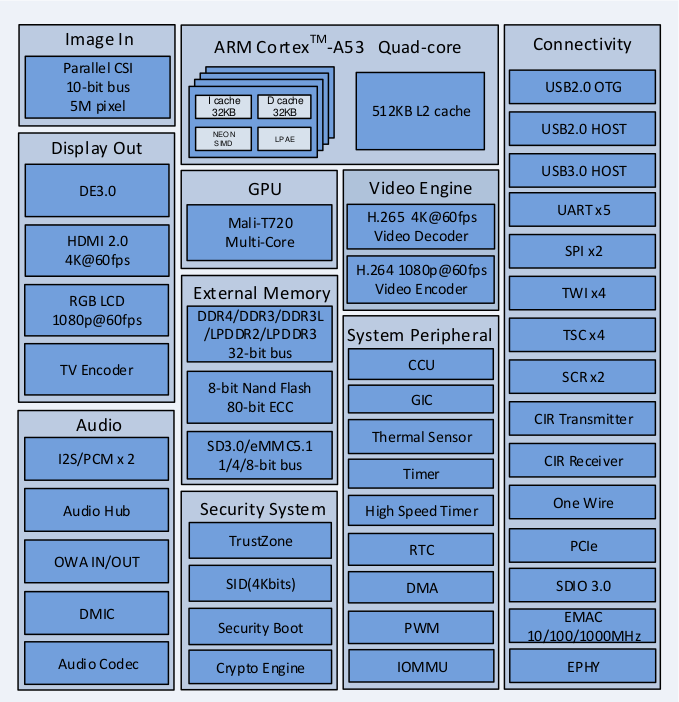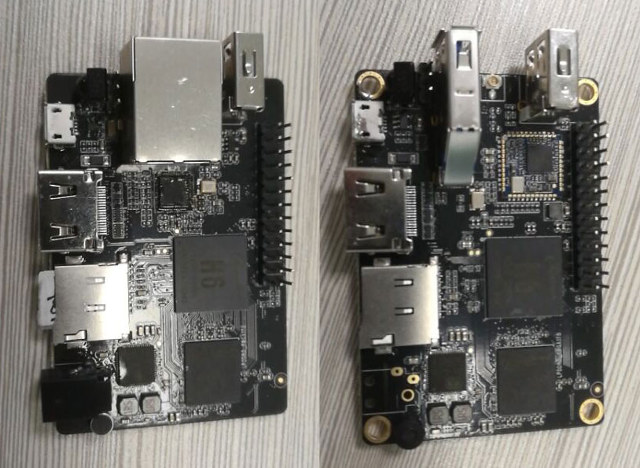Putting aside the ill-fated Allwinner A80 SoC, Allwinner H6 is the first Allwinner processor with multiple high speed interfaces such as Gigabit Ethernet, USB 3.0 and PCIe, and also support 4K HDR with the company’s Smart Color Engine for video processing. So far, it’s been found in some 4K HDR TV boxes such as Zidoo H6 Pro or Beelink GS1.
We’ve already known Shenzhen Xunlong was working on Orange Pi 3 Plus board with the processor for a few months, but Pine64 appear to have joined the party, and will soon launch Pine64 H64 board according to their Wiki. No photos yet, but the company released various documents for the board including Allwinner H6 V200 datasheet (80 pages), and Allwinner H6 V200 user manual (965 pages).

The documents should – for instance – allow sunxi-linux community to port drivers for the processor.
Some corrections have been made to the first list of specifications, for example video encoding is now limited to 1080p @ 60 fps instead of 4K @ 30 fps. and the wiki confirms the CPU frequency is limited to 1488 MHz instead of the 1.8 GHz reporting by CPU-Z or marketing materials, and X-Powers AXP805 will be the companion chip / PMIC for Allwinner H6 (V200).
Today we also got some more information about the Allwinner H6 development boards, none of which are available yet, with some photos from Shenzhen Xunlong‘s H6 Orange Pi One with Gigabit Ethernet, and H6 Orange Pi Lite with WiFi (RTL8189ETV) and one USB 3.0 port.

That means we’ll have at least four Allwinner H6 SBCs around the beginning of next year. An Allwinner H6 SDK (RC4 – not final) with Linux 3.10. can also be found on MEGA. Another Linux 4.4 SDK should come in Q1 2018.

Jean-Luc started CNX Software in 2010 as a part-time endeavor, before quitting his job as a software engineering manager, and starting to write daily news, and reviews full time later in 2011.
Support CNX Software! Donate via cryptocurrencies, become a Patron on Patreon, or purchase goods on Amazon or Aliexpress





Still old android kernels. But better then nothing.
I doubt 80 pages for a datasheet of such a complex chip is enough.
I wonder with that choice, USB 3.0 and wifi. Wouldn’t the USB 3.0 interfere with the 2.4 GHz wifi?
I wonder if the encoder can still do 4K@30FPS? They had to change the encoding spec because they have a CSI interface for the camera. CSI is bandwidth limited to 5MP. 4K is 8MP. There is no way to hook a 40K@30FPS sensor to this unit, you need a MIPI sensor interface. Allwinner definitely has the IP for 4K sensors, it is in the V3.
No MIPI DSI for the display? I can live with parallel RGB but it is a whole lot of wires. I am actually becoming a fan of MIPI-DSI/CSI since it eliminates over 50 runs on the PCB and makes the connectors smaller.
How does pricing compare to the A64?
Linux 3.10 is EOL in 15 days. Why are they releasing new hardware using 3.10? 4.4 is good until Feb 2022.
@KopiJahe
Very likely, but it only happens when it’s actively being used. Had this problem with a router I was involved in developing, wasn’t a whole lot of fun, as we had to re-design the entire PCB…
But do you really think these Chinese companies that sell $20-30 boards will care?
@Jon Smirl
You ever talked to AllWinner? They’re all about cost and not about putting the best features.
From my meeting with them and RockChip, I’d say the latter is heading the in the right direction whereas AllWinner doesn’t really care unless you’re coming with a multi-million product order.
For whatever reason, these chip makers are stuck using old, outdated features, because it’s cheaper…
Using an RGB LCD interface has no cost, whereas MIPI carries a licensing cost. I guess they feel the camera interface is expensive enough…
Why do you think many of them are still stuck using old Mali MP400/MP450 graphics?
@TLS
The A64 has MIPI DSI, that is the chip we currently use. This is some mess between the H group and the A group. I suspect when the A version of the H6 appears it will have the MIPI DSI interface and probably a MIPI CSI camera.
The problem with RGB LCDs is that it takes so many pins. On the A64 you can have parallel LCD or Ethernet, but not both. That is why we are using a MIPI display with it. You can have MIPI DSI and Ethernet at the same time.
The cost of a MIPI display is not that different than the parallel ones. Many of the LCD controllers work in both modes so the cost difference is zero.
i need pmic+soc only on sbc. and i only need periphery what is in soc, but it must be implemented ideally. no external chip should be installed: there must be neither usb hub (especially stt hubs) nor wifi (especially ugly 1t1r) nor usb-ethernet (especially behind hubs).
and what do I see? a very difficult choice: either shitty sdio-connected rtl8189 (thanks that not xr819) but with usb3 or gbe but only with usb2.
@Jon Smirl
Have you looked at Habey’s “EMB-2230” SBC runs Linux on an i.MX6, and offers LVDS and MIPI-DSI/CSI links, -10 to 60°C support, a 40-pin GPIO header, and optional PoE. Linuxgizmos
@theguyuk
We manufacture our own boards. The case they fit into is oddly shaped so off the shelf stuff doesn’t fit. For our stuff a normal SBC type board is broken into three PCBs and linked via FPC cables. Plus some other custom electronics is added including four radios.
@Jon Smirl – We just ran a small batch of custom A64 boards, with MIPI-DSI, but I can’t for the life of me get the touchscreen display to power up / show an image with any combination of mainline u-boot, allwinner BSP u-boot, mainline kernel, and BSP kernel 3.10. (HDMI output works fine). The panel works perfect in Android, but no luck with linux yet.
Got any hints on what to enable in u-boot or kernel config?
Thanks!
waiting for tkaiser…
…is busy playing with those small new Xunlong dev board samples, the PCIe pins on the 26 pin header and the new Xunlong ‘mPCIe HAT’. 2 SATA ports with ASMedia ASM1061 –> check, 4 SATA ports with Marvell 88SE9215 –> check, 3 x additional Gigabit Ethernet with PCIe multiplexer and Intel I211 –> check!
(just kidding 😉 )
@miniNodes
Our MIPI stuff is done by a remote developer, I can ask when he wakes up. But we run Android, I don’t think he did anything special. He just changed the stuff in the Allwinner fex config to match the panel and it came right up.
We are running the BPI Android port that supports MIPI. We started on BPI boards before doing our own.
@miniNodes
Do the BPI Linux images work with MIPI? The labels on the downloads are not clear. We used the LCD version of Android download.
http://www.banana-pi.org/m64-download.html
They sell a MIPI screen for the M64.
Yeah,4xTs inputs?
Now dreaming from a h6 board/box with 4x sat-tuners combined
with uptodate Silicon Labs DVB-s2x demodulators…awesome
*cnx news check frequency intensifies*
@TC
Sorry, I was really just kidding (though yesterday Xunlong dev samples arrived but only ‘boring’ ones with H3 and H5, still testing with OPi Zero Plus and also still excited). No idea what Xunlong is planning wrt H6… just hoping for PCIe since the use cases I’m interested in need IO and network bandwidth.
With Pine’s H64 board we know that PCIe will be exposed (as mPCIe slot being fully compliant to specs so even USB2 on pins 36/38 available but then one of the 2 type A USB2 receptacles can not be used in parallel) but as usual software situation is the most important factor since it’s about being able to use the hardware features or not.
Currently it looks promising, we got documentation without confidental watermarks, there’s a developer contact at Allwinner who even made his first edit in linux-sunxi wiki already (yay!). But 3.10 kernel drop and most probably the 4.4 arriving soon not in the best shape (doing things Allwinner and not mainline style I would assume). Again: no idea, time will tell. I really hope Allwinner commits themselves towards open source. Not since I believe that there would be a relevant SBC or Linux market but just since leaving the ‘port and forget’ route would also help them internally (almost all other ARM SoC vendors understood in the meantime and save a lot of coding efforts by contributing upstream).
With an ethernet switch and pcie wifi chip, we got a good router solution, and it can support Amazon Echo like function and act as a set-top-box